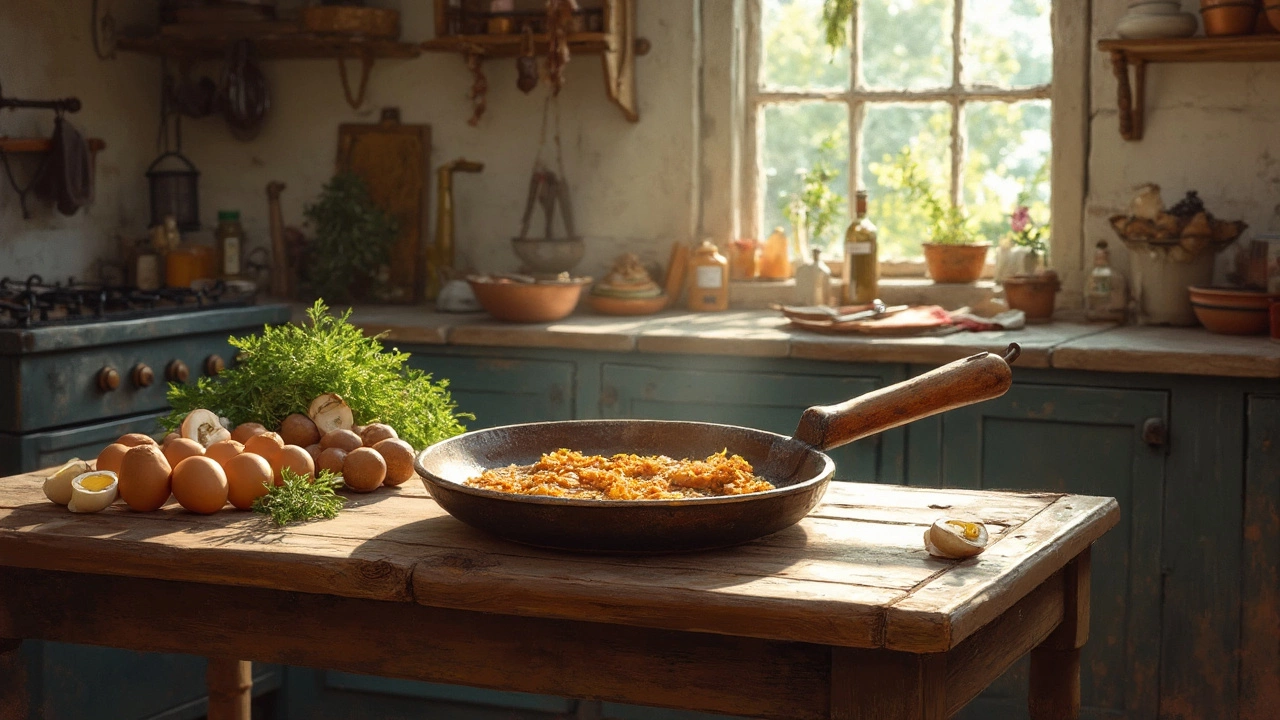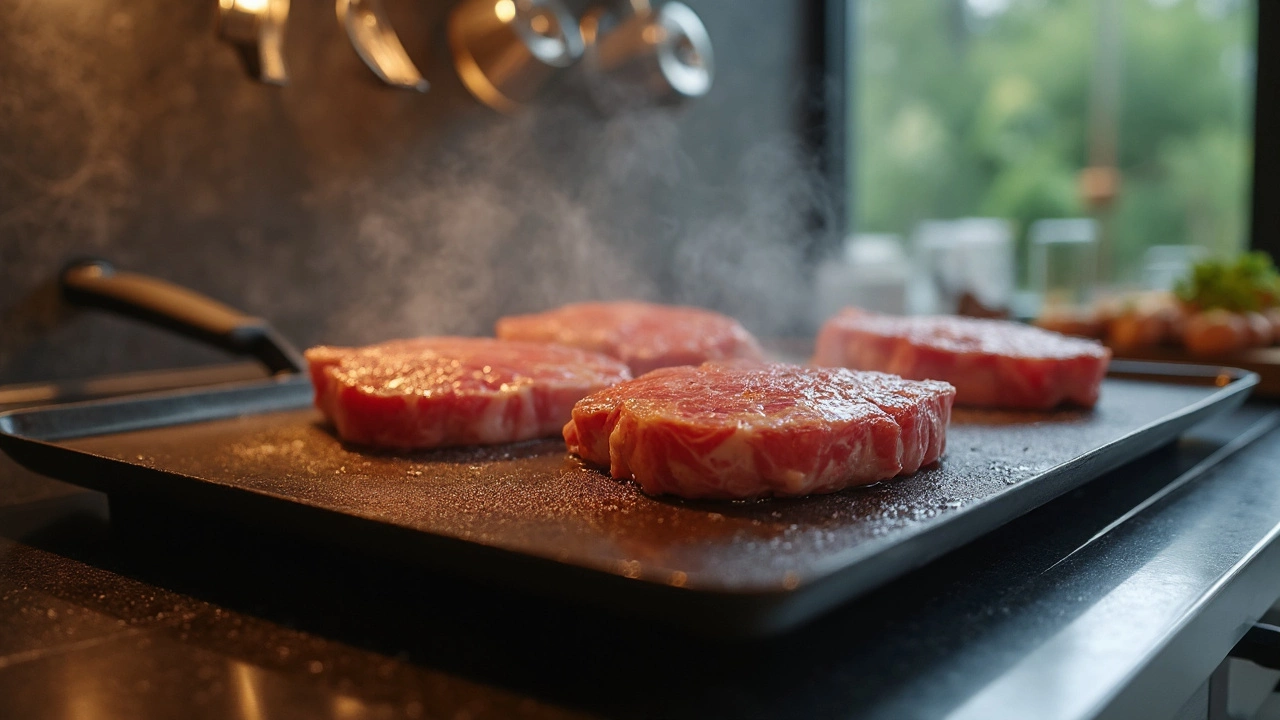Understanding the Wonders of the Flat Pan
 Mar, 29 2025
Mar, 29 2025
You've probably seen a flat pan in many kitchens, maybe even used one. But have you ever thought, what's it really called and how can it make my cooking better? Let's peel back the mystery! Commonly known as a griddle, this trusty tool is a flat surface usually with a handle, perfect for flipping pancakes or grilling a cheese sandwich to melt-in-your-mouth perfection.
Flat pans aren't just for breakfast, though. Imagine searing a steak or grilling veggies without losing those precious juices. The flat design helps distribute heat evenly, meaning no cold spots to fret over. It's versatile, easy to handle, and a staple that might just become your new best friend in the kitchen.
- What Exactly Is a Flat Pan?
- Different Types and Uses
- Caring for Your Flat Pan
- Tips for Getting the Best Out of It
What Exactly Is a Flat Pan?
A flat pan is a kitchenware staple that you might use more often than you think. Known commonly as a griddle, it usually features a broad, flat surface and sometimes a handle for easy maneuvering. This design is all about simplicity and effectiveness, making it a go-to for a variety of cooking tasks.
Why's it so handy? Well, a griddle offers a large cooking area compared to regular pans. This means you can batch cook pancakes or whip up a whole breakfast for the family in one go. Whether you're a pancake aficionado or just like the occasional stir-fry, its size and shape keep things convenient.
Now, let's talk about the material. Flat pans come in different materials like cast iron, non-stick, and stainless steel. Each has its own perks. For instance, cast iron retains heat like a boss and is perfect for getting a crispy edge on foods. Non-stick, as the name suggests, helps you out when you're dealing with sticky situations. Stainless steel, meanwhile, is a durable option, great for high-heat cooking.
Here's a fun fact for you: some griddles even come with a stove top feature, meaning you can use them both on the stove and in the oven. Talk about versatility! With this in mind, it's no wonder the griddle holds a special place both in homes and diners across the globe.
Different Types and Uses
So, you've got your flat pan ready, but did you know there are different types, each with its own set of uses? Let's dig in and break it down. One popular type is the cast iron griddle. Cast iron is a powerhouse in the kitchen—it's heavy, retains heat like a pro, and gives your pancakes those beautiful golden edges. All it takes is a little seasoning and some care to make it last a lifetime.
Then there's the non-stick griddle, the lifesaver for those who want an easier clean-up and less sticking. Perfect for mornings when you don't want to fuss about too much. Scrambled eggs or a quick grilled cheese? This one's your buddy.
And we can't forget the electric griddle. If you hate juggling multiple pans on a stove, the electric griddle offers a massive cooking surface. It's ideal for cooking breakfast for a crowd—think pancakes, bacon, and eggs all at once without leaving anyone hungry!
Each of these can transform your cooking game:
- Cast iron griddles: Best for high heat cooking and developing flavors over time.
- Non-stick griddles: Great for easy handling and quick meals.
- Electric griddles: Perfect for large family cook-ups and batch cooking.
If you're into numbers, a quick survey shows the average home might use a griddle about 3 times a week for breakfasts alone. That's not a surprise given how effortlessly they can handle popular dishes!

Caring for Your Flat Pan
Taking care of your flat pan isn't rocket science, but a little bit of effort can keep it performing like a champ. Whether you use it every day or just for special occasions, proper maintenance is key.
Start by cleaning your pan after each use. Wait for it to cool down, and then wipe it with a soft sponge and warm soapy water. Harsh scrubbers can scratch the surface, especially if it's non-stick, so be gentle. Got a stubborn stain? Let it soak for a bit before trying again.
Drying your flat pan immediately after washing is crucial. This prevents any rust from sneaking up and ruining your trusty cooking partner. A quick wipe with a soft towel should do the trick.
- Season it: If your pan is made of cast iron, remember to season it occasionally. A light layer of cooking oil spread evenly and heated on the stove can work wonders.
- Store it correctly: Hang it up to avoid scratches or stack with a protective layer, like a paper towel, if it's going in a cabinet with other cookware.
Here's a quick glance at some basics for different pan materials:
| Material | Care Tip |
|---|---|
| Non-stick | Avoid metal utensils and high heat to keep the coating intact. |
| Cast Iron | Don't soak in water for long; always dry immediately and apply a thin coat of oil. |
| Stainless Steel | Good for high heat; avoid chlorine-based cleaners to keep it shiny. |
Remember, a little love goes a long way in maintaining your cookware. Treat your flat pan right, and it'll serve you well, dishing out delightful meals time after time.
Tips for Getting the Best Out of It
Using a flat pan isn’t just about tossing food on it and hoping for the best. Here are some tips to elevate your cooking game and make the most out of this handy kitchen tool.
1. Preheat for Perfect Results: Always preheat your flat pan before cooking. It ensures even cooking and helps achieve that desirable golden crust, especially for foods like pancakes or fried eggs.
- Turn on medium heat and let the pan warm up for about 5 minutes.
- To check if it's ready, splash a few drops of water; they should sizzle and evaporate quickly.
2. Use the Right Amount of Oil: A light coat of oil or butter can prevent sticking and also add flavor. Too much can lead to greasy results, so remember, less is more!
- Use a paper towel to coat the surface with a thin, even layer.
- Try different oils like olive oil for mild flavors or sesame oil for an Asian twist.
3. Clean with Care: A well-maintained flat pan is a long-lasting one. Forget about the dishwasher; cleaning by hand is the way to go.
- Let the pan cool before washing to prevent warping.
- Use warm soapy water and a non-abrasive scrubber.
- Dry it thoroughly to avoid rust, especially if it's cast iron.
4. Experiment with Dishes: Don’t limit yourself to breakfast. Try searing steaks or seafood, griddling sandwiches, or even warming tortillas. The sky is the limit!
A quick side note—numerous cooks report that using a flat pan reduces cooking time by up to 20% compared to a traditional pan. This makes it not only versatile but also a time-saver!
Mastering these tips can turn your everyday meals into culinary masterpieces right from the comfort of your own kitchen.